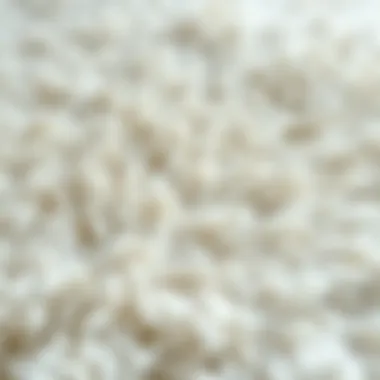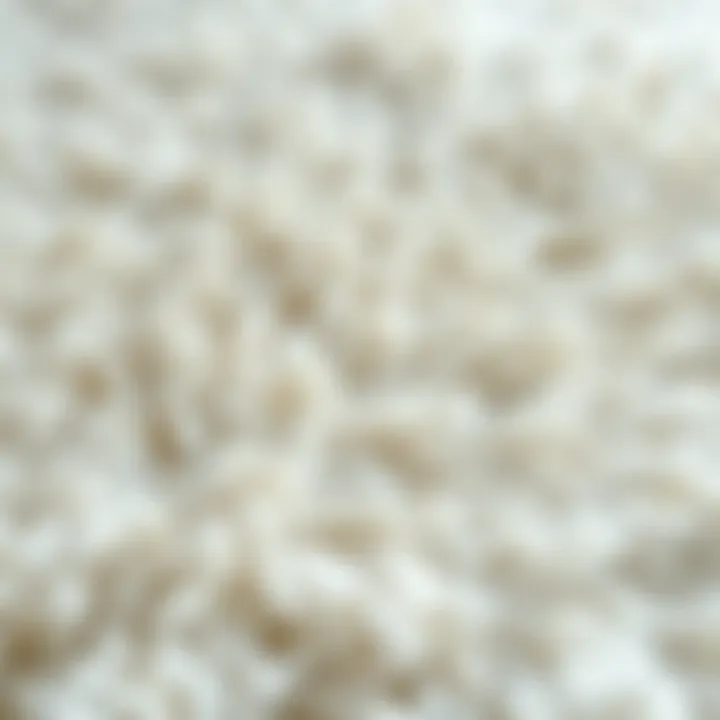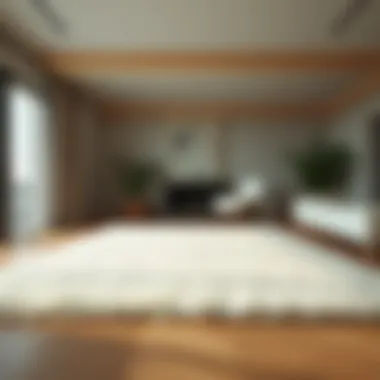Ultimate Guide to Cleaning Your Shaggy White Rug


Intro
Cleaning a shaggy white rug isn’t just a chore; it's a delicate dance of techniques and tools to maintain its beauty and plush texture. Shaggy rugs have a unique appeal, often acting as the centerpiece of a room with their soft fibers and inviting appearance. However, their color and texture can pose significant challenges that require specialized care. This guide lays out the essentials needed for effective cleaning and maintenance of a shaggy white rug. From identifying the right cleaning methods to employing proper tools, we aim to equip you with the knowledge necessary for preserving your rug’s integrity.
By understanding both the unique characteristics of shaggy rugs and the best practices for keeping them pristine, we can create living spaces that feel both welcoming and stylish. Throughout this guide, readers will find practical advice tailored to home enthusiasts and condition-conscious individuals, ensuring that your shaggy white rug remains a beautiful addition to your space for years to come.
Understanding Shaggy Rugs
Cleaning a shaggy rug goes beyond just sprucing up your living space; it’s about understanding the unique characteristics of these carpets. Shaggy rugs, known for their plush, luxurious feel, can elevate a room’s ambience. However, they also demand particular care due to their construction and material. Learning about shaggy rugs helps in devising effective cleaning strategies and maintaining their appeal over time, which is crucial for anyone aiming for a stylish and inviting home.
What is a Shaggy Rug?
A shaggy rug is generally recognized for its long, twisted fibers that create a fluffy and textured surface. Unlike traditional rugs, where the pile is short and denser, shaggy rugs offer a softer and more casual vibe. They come in various lengths, ranging from a few inches to several inches, depending on design.
Typically, shaggy rugs are used in living rooms, bedrooms, or anywhere you'd want to cozy up. Besides aesthetics, they function well as sound barriers, absorbing noise and providing warmth to tiled or hardwood floors. They’re often a hotspot for lounging, but that also means they’re quick to show dirt, dust, and other residues.
Materials Utilized in Shaggy Rugs
Shaggy rugs can be made from a variety of materials, and understanding these can help in choosing the right cleaning method:
- Polyester: A popular synthetic option, resistant to stains, easy to clean, and often softer than natural fibers.
- Wool: A natural choice known for its durability and comfort, but it may require more careful maintenance to avoid moth damage.
- Acrylic: Similar in feel to wool, acrylic is lighter and tends to be more affordable, though not as long-lasting.
- Cotton: While not as common, cotton shaggy rugs are machine washable but may wear out faster.
Each material comes with its own set of strengths and weaknesses, which affects how you should clean and care for the rug. The choice often hinges on personal preference, lifestyle, and the amount of foot traffic a rug sees.
Why Choose a White Shaggy Rug?
Opting for a white shaggy rug can be a bold decision, yet it brings a unique charm to a space. Here are a few reasons this color choice might be worth considering:
- Aesthetic Appeal: White shaggy rugs can brighten up any room, providing a fresh and clean look. They can easily match various decor styles, from minimalist to bohemian.
- Versatility: They act as blank canvases, meaning you can swap around decor styles without needing to change your rug.
- Luxurious Feel: The long fibers scream comfort, often making them the focal point of a cozy corner or living area.
- Light Reflection: This color can enhance the light in a room, making spaces feel larger and more inviting.
However, with these appeal comes the work of keeping it clean. Ongoing maintenance is critical to maintain the rug’s luster, as dirt and stains can be more prominent on a white surface. Choosing a white shaggy rug is about striking a balance between style and the commitment of upkeep.
Identifying Common Stains and Dirt Sources
Understanding the types of dirt and stains your shaggy white rug encounters is vital for effective maintenance. This knowledge allows you to act quickly in addressing issues before they become permanent. It also helps you select the right cleaning methods and products, ultimately preserving your rug's beauty and lifespan.
Natural vs. Accidental Stains
Natural stains are commmonly caused by organic materials like food, mud, or pet drops. They typically blend in with the fibers of the rug, making them harder to detect right away. Accidental stains, on the other hand, stem from unforeseen spills or mishaps. One example could be a glass of wine tipping over during a dinner party.
- Common Natural Stains:
- Common Accidental Stains:
- Coffee spills
- Chocolate marks
- Grass stains
- Ink from a pen
- Paint splatters
- Nail polish spills
Both kinds of stains require immediate attention. If left unattended, they may settle deep in the rug fibers. Removing them promptly keeps the aesthetic appeal of your rug intact.
Environmental Contaminants
Shaggy rugs are like magnet – they attract dirt, dust, and other contaminants that float around your home. Environmental pollutants can accumulate over time, especially if your rug is in a high-traffic area or near an open window. Dirty shoes or outdoor elements like pollen can introduce extra dirt.
- Airborne Pollutants: These include dust and pollen. They may not cause visible stains but can dull the rug's engagement over time.
- Outdoor Dirt: If your rug lies near doorways or exits, it's likely to collect mud and grime with every entry and exit.
Regular vacuuming can help minimize these unseen foes. Remember, the key is not just to spot clean but to keep the entire rug looking its best.
Daily Wear and Tear
Daily activities naturally lead to wear and tear on your shaggy white rug. Foot traffic, for instance, can compress fibers and lead to a more matted appearance.
- High-Traffic Areas: Rugs in hallways or living rooms are particularly prone to daily dirt accumulation. Just think about how many times folks walk through your home.
- Animal Activity: Pets can be both a joy and a challenge for rug care. Their playful antics might leave behind fur and dander.
This consistent wear can compromise both the look and feel of the rug if neglected. By keeping an eye on these daily impacts, you can intervene with cleaning methods that specifically target the unique challenges posed by regular use.


Preparation for Cleaning
Before diving into the nitty-gritty of cleaning a shaggy white rug, having the right preparations in place can save you time and effort in the long run. Preparation is not just about gathering supplies; it also encompasses creating suitable conditions in your home for a successful cleaning process. Identifying and understanding these initial steps sets the stage for effective maintenance and care of your beloved rug, ensuring you achieve the best results with each clean.
Gathering Essential Supplies
First and foremost, you’ll want to compile a reliable set of cleaning supplies. Having your tools and solutions ready will not only streamline your cleaning process but will also ensure you are equipped to tackle any stain or dirt that may come your way. Here’s a list of must-have items:
- Vacuum cleaner: Opt for one with a hose attachment to reach deeper into the shag.
- Broom: A soft-bristled broom can be useful for dusting before vacuuming.
- Cleaning solutions: Consider both homemade remedies, like a mix of vinegar and water, and store-bought options labeled safe for rugs.
- Microfiber cloths: Great for spot cleaning and absorbing spills.
- Bucket: Handy for mixing your solutions or soaking sections of the rug if need be.
- Stiff brush: Useful for scrubbing out stubborn stains without damaging the fibers.
- Rubber gloves: Protect your hands when using cleaning chemicals.
By having these essential supplies at your fingertips, you lower the chances of interruptions while cleaning, making the process far more efficient.
Creating a Safe Cleaning Environment
Next up is the environment in which you will be cleaning. You don't want to be tripping over furniture or getting distracted by a cluttered space while trying to restore your rug's glory. Here’re a few pointers for establishing a safe zone:
- Clear the Area: Move any furnishings, accessories, or obstacles from around the rug. This not only protects your furniture but also creates a spacious backdrop for your cleaning efforts.
- Ventilation: Open windows and doors to promote air circulation, especially if you’re using any cleaning agents that may have strong odors. Fresh air can also help speed up drying time.
- Favorable Lighting: Good lighting is paramount for identifying stains or areas needing special attention. Ensure the room is well-lit to make spotting dirt easier.
By laying down this groundwork, you’re not just optimizing your cleaning method; you’re also cultivating a space where you can focus entirely on the task at hand.
Assessing the Rug's Fabric Properties
Finally, understanding what your rug is made of can be a game changer when it comes to cleaning. Different fibers require varying care techniques. Generally, shaggy rugs can be made from natural fibers such as wool or synthetic materials like polyester. Here’s how to differentiate:
- Natural Fibers (like wool or cotton): These typically require more gentle cleaning techniques. Harsh treatments can lead to fading or shrinkage.
- Synthetic Fibers (like acrylic or polypropylene): Often more resilient. These may stand up better to heavy scrubbing but check if they’re labeled as safe for such treatment.
Assessing the fabric will not only guide your cleaning methods but heavily influence the tools and chemicals you choose to use.
Understanding these properties lays a solid foundation for effective cleaning. With preparation done right, you can move ahead with confidence into the actual cleaning process.
Dusting and Vacuuming Techniques
When it comes to keeping a shaggy white rug looking its best, the often underrated practice of dusting and vacuuming plays a crucial role. Regular maintenance not only enhances the appearance of the rug but also prolongs its lifespan. Dust and dirt can quickly accumulate in the deep fibers of a shaggy rug, leading to discoloration and potential damage if not addressed promptly. Moreover, removing these particles regularly can improve indoor air quality, which is particularly important for those with allergies or respiratory issues.
Using a Vacuum with Proper Attachments
To effectively manage dust and debris, it's essential to choose a vacuum cleaner equipped with attachments suitable for shaggy rugs. Most importantly, a gentle brush or upholstery attachment is preferred, as these minimize the risk of snagging or pulling fibers. Opt for a canister or upright vacuum that allows for adjustable suction settings; high suction can demolish the integrity of those long, luxurious fibers. It’s wise to steer clear of beater bars, which, although useful for flat carpets, may wreak havoc on a shaggy rug's pile.
Tip: Always thoroughly check the manufacturer's recommendations for your specific rug to ensure the vacuum settings are appropriate.
Manual Dusting Methods
Sometimes, it might not be practical to vacuum. Manual dusting can be a superb alternative, especially between vacuum sessions. One can use a soft-bristled broom or a fur brush, which is effective for fluffing the fibers while simultaneously lifting dust and dirt. When dusting manually, it’s important to move in the direction of the rug's pile to avoid matting the fibers. Another method that may be useful is shaking the rug outdoors, if feasible, allowing loose dirt to fall away freely.
- Tip 1: Be sure to do this in a gentle manner; you do not want to harm the rug's structure.
- Tip 2: Using a lint roller can also be beneficial for quick clean-ups in case of pet hairs or debris.
Frequency of Dust Removal
Determining how often you should dust and vacuum your shaggy rug often hinges on your living environment. For rugs placed in high-traffic areas, daily dusting or vacuuming may be needed to keep them looking fresh. For less frequented spaces, such as guest rooms, a weekly routine may suffice. Whatever your scenario, it’s prudent to keep an eye on the rug's appearance and adjust your cleaning schedule accordingly.
In addition to regular cleaning, a deep clean at least once every few months can preserve the rug’s texture and color, making sure it stays a charming centerpiece in your home.
Stain Removal Techniques
Maintaining the pristine white color of a shaggy rug is no small feat, especially when it comes to dealing with stains. This section delves into various stain removal techniques vital for keeping your rug looking its best. The approach you choose can significantly impact how well you eliminate stains without compromising the texture or color of the rug.
Spot Cleaning Essentials
Spot cleaning is the first line of defense when it comes to tackling stains on your shaggy white rug. Addressing spills and marks as soon as they happen not only helps in minimizing the damage but also prevents stains from settling in. Here are key aspects to remember:
- Act Quickly: Time is of the essence. As soon as you notice a stain, grab a clean cloth or paper towel to blot the affected area gently. Avoid rubbing, as that may spread the stain further into the fibers.
- Test Before You Tackle: If you are using a cleaning solution, apply it on a hidden part of the rug first. This way, you can double-check that it won’t discolor or harm the fabric.
- Blot, Don't Rub: Gently blotting helps absorb the liquid without pushing it deeper into the fibers. Use a dabbing motion for the best result.
Homemade Solutions for Effective Cleaning


Many households turn to homemade cleaning solutions that are both effective and safe for shaggy white rugs. Utilizing natural ingredients not only helps in stain removal but is also kinder to the environment. Here are some natural concoctions you can easily whip up:
- Baking Soda Paste: Mix baking soda with a small amount of water to form a paste. Apply this on tougher stains and let sit for about 15 minutes before blotting with a damp cloth.
- Vinegar Solution: Combine equal parts white vinegar and water in a spray bottle. Lightly spray the solution on the stain, letting it sit for a few moments before blotting it away. Vinegar works wonders at lifting stains and neutralizing odors.
- Dish Soap Mixture: A tablespoon of dish soap mixed with two cups of water can do wonders. Apply a small amount to the stain and blot until the stain lifts.
Remember: Always rinse the area with water after using a solution to remove any residue, which could lead to dirt attracting in the future.
Commercial Cleaners: When and How to Use
Sometimes, stains can be stubborn enough to require the extra muscle of a commercial cleaner. However, using them also demands caution to avoid damaging your shaggy rug. Here are some tips:
- Choose Wisely: Look for pH balanced cleaners that are specifically designed for wool or synthetic fibers, as per your rug's material. Brands like Rug Doctor and Bissell offer solutions aimed at deep cleaning while being gentle on fibers.
- Follow the Instructions: Each product will come with its own guidelines. Following these closely can save you from mishaps such as discoloration or damage.
- Spot Test is Key: Just like with homemade solutions, a patch test is crucial. Apply the cleaner on a small, inconspicuous part of the rug before using it on a stained area.
- Avoid Overlapping Products: If you’ve already used a homemade cleaner, avoid layering commercial products on top, as this could cause adverse reactions that might affect the rug.
Closure
Stain removal is an ongoing challenge but understanding the right techniques can make all the difference. Whether you opt for immediate spot cleaning, rely on homemade solutions, or turn to commercial cleaners, being informed will empower you to tackle any mess head-on.
Deep Cleaning Approaches
Deep cleaning a shaggy white rug is a crucial aspect of maintenance that goes far beyond regular vacuuming and spot cleaning. Shaggy rugs, with their long fibers, can trap dirt, allergens, and odors deep within their structure. Without proper deep cleaning, these contaminants can build up, diminishing the rug's appeal and potentially impacting indoor air quality. This section explores different deep cleaning methods, their benefits, and considerations to uphold the integrity and appearance of your rug.
Using a Carpet Cleaner Machine
Employing a carpet cleaner machine can be a game changer when it comes to deep cleaning a shaggy rug. These machines are designed to penetrate the fibers deeply, extracting dirt and grime that would be nearly impossible to remove manually. When choosing a carpet cleaner, ensure that it has adjustable settings suitable for shaggy rugs to prevent damage during the process.
Benefits of Using a Carpet Cleaner Machine:
- Deep Cleaning: Effectively removes stains and buildup from deep within the fibers.
- Water Extraction: Reduces moisture left in the rug after cleaning, minimizing mold risks.
- Time Efficiency: Covers larger areas quickly compared to hand washing.
Before starting, it’s wise to perform a patch test on a small, inconspicuous area of your rug to ensure colorfastness. It’s best to use a cleaning solution that’s safe for the type of fibers in your rug, specifically designed for rugs or with mild ingredients to avoid discoloration.
Hand-Washing Techniques
When it comes to deep cleaning your shaggy rug, hand-washing might seem labor-intensive, but it has its undeniable advantages. This method provides you with more control over the cleaning process and can be gentler on the fibers compared to machines.
Steps to Hand-Wash Your Shaggy Rug:
- Prepare the Area: Choose an outdoor space like a patio or balcony to keep water away from your home interiors.
- Rinse the Rug: Start by rinsing the rug with cold water to remove loose dirt and debris. Use a hose if available.
- Create a Gentle Cleaning Solution: Mix a small amount of mild dish soap or a specialized carpet cleaner with water in a bucket.
- Scrub Gently: Using a soft-bristled brush, apply the soap solution and gently scrub the rug, avoiding too much agitation that might distort the fibers.
- Rinse Thoroughly: Ensure that all soap residue is removed by rinsing multiple times with clean water.
- Dry Completely: Lay the rug flat to dry, steering clear of direct sunlight to prevent fading.
Hand-washing allows you to spot-treat specific areas where dirt is more stubborn, ensuring a more thorough clean without risking the rug's integrity.
Maintaining Rug Integrity During Deep Clean
While deep cleaning is essential for restoring the brilliance of a shaggy white rug, it’s equally important to maintain its integrity throughout the process. Shag rugs can be delicate, and improper cleaning methods can lead to fraying or loss of texture.
Key Considerations for Maintaining Integrity:
- Avoid Heavy Chemicals: Use mild detergents or eco-friendly cleaners to prevent the degradation of fibers.
- Gentle Handling: Always be gentle in your cleaning methods, whether using a machine or washing by hand.
- Ensure Proper Drying: After cleaning, make sure the rug is dried completely to prevent mold growth and maintain structural integrity. Snapping or stretching it during the drying process can help restore its shape.
Preventive care is always better than cure. Routine vacuuming and immediate spot treatment can prolong the life of your shaggy white rug, reducing the need for frequent deep cleans.
Drying and Restoration Methods
Cleaning a shaggy white rug isn’t just about removing stains or dirt; it’s also critical to address how to effectively dry and restore the rug after cleaning. Getting this step right is pivotal to maintaining the rug’s texture and appearance while prolonging its life. When a rug retains moisture, it can lead to mold growth or a musty smell, undermining all the efforts put into cleaning. Thus, understanding the right drying techniques and how to restore the original feel of the rug is essential.
Proper Drying Techniques
Once your rug is cleaned, whether through a deep clean or spot treatment, the drying process begins. This phase can make or break the rug’s condition. Here are some effective drying techniques:
- Air Drying: For natural fabrics, the best option is to lay the rug flat in a well-ventilated area away from direct sunlight to avoid fading. Using fans can facilitate air circulation, reducing drying time without compromising the material.
- Avoid Heat Sources: Resist the urge to use hair dryers or radiators. Excessive heat can warp fibers and ruin the shape of your shag.
- Flip the Rug: If feasible, flip the rug over halfway through the drying process to ensure balanced drying and prevent moisture build-up.
Keeping an eye on the rug during drying is vital. Excess moisture can lead to a range of issues that aren’t worth the risk.
Restoring Rug's Original Texture


Restoring the fluffy texture that is synonymous with shaggy rugs can be quite the task, but it's necessary to ensure it remains cozy and inviting. Here are steps to achieve this:
- Gently Fluff: Once the rug is completely dry, use a stiff broom or a damp cloth to gently fluff the fibers, lifting them back to their former glory. This helps redistributes fibers that may have become compacted during the cleaning process.
- Steam Treatment: For stubborn flat areas, a gentle steam treatment can help. Hold a steam cleaner about six inches away to allow moisture without soaking it. Be cautious, as over-steaming can damage the fibers.
- Brush with Purpose: Using a pet brush or a special rug rake can reinvigorate the shag. This tool allows you to reach down into the fibers, lifting them effectively and restoring that plush feel.
Realizing When to Seek Professional Help
Even the most dedicated homeowner might find themselves stumped when it comes to the drying and restoration of a shaggy rug. There’s no harm in acknowledging that some jobs are best left to the pros. Here’s when to consider calling for help:
- Persistent Odors: If there’s a lingering mustiness that refuses to dissipate, it could indicate hidden mold or mildew that requires special equipment to treat.
- Material Issues: Rugs made from delicate fibers may need professional attention to avoid damage. Specialized cleaning services are experienced with different materials.
- Heavily Soiled Rugs: When a rug has been heavily stained or needs thorough cleaning beyond your capabilities, professional services can provide deeper cleaning techniques that ensure your rug remains intact.
"Knowing when to call in the cavalry can save you a lot of heartache down the line. Professional services can bring rugs back to life in ways that DIY cleaning sometimes just can’t match."
Maintaining a Shaggy White Rug
Caring for a shaggy white rug is not just about keeping it looking good. It's about maintaining an investment that can elevate the ambiance of any space. Shaggy rugs, known for their lush and fluffy texture, act as natural sound insulators and contribute to a warm and inviting atmosphere. Moreover, keeping a shaggy rug clean and well-maintained ensures it lasts longer, retaining its beauty while minimizing the risk of damage or unattractive stains.
Being proactive matters. If you consistently attend to your rug’s needs, you’ll save yourself a hefty sum down the line and maintain your home's aesthetics.
Establishing a Routine Cleaning Schedule
Establishing a routine cleaning schedule is key to extending the life of your shaggy white rug. Consistency in cleaning helps prevent dirt, dust, and stains from embedding into the fibers.
Consider adopting the following cleaning frequency:
- Weekly Vacuuming: This should be a priority. Use a vacuum with adjustable height settings or one designed for shag rugs. Not all vacuums are created equal; avoid one that is too powerful, which may damage the fibers.
- Monthly Spot Checks: Do a visual check monthly to identify any spots or stains forming. Address them before they become permanent.
- Quarterly Deep Clean: Deep clean every three months. This can involve professional cleaning services or using a shampoo machine at home.
Creating this rhythm can turn cleaning into a habit, fostering a clean and vibrant living environment.
Preventative Measures for Stains
Prevention is often more effective than cure when it comes to maintaining a shaggy white rug. A few steps can save you from significant headaches down the road:
- Use Area Rugs in High-Traffic Zones: Cover that plush rug in places where people frequently walk or sit. It’ll reduce wear and tear significantly.
- Implement No-Shoe Policy: Enforce a household rule that shoes must be removed when indoors. This simple action can dramatically lessen the dirt and grime that comes into contact with your rug.
- Apply Fabric Protector: Consider using a fabric protector designed specifically for rugs after a deep clean. This can help repel stains and spills, providing an extra layer of security.
Taking these preventative measures can significantly prolong the lifespan and condition of your rug, ensuring it remains a centerpiece in your home.
Periodic Professional Cleaning Importance
Even with a solid routine in place, a shaggy white rug will benefit immensely from professional deep cleaning every now and then. This isn't merely about appearance; it is also about health.
- Specialized Equipment: Professionals use state-of-the-art tools that can clean deeply without risking damage to the fibers.
- Expertise and Experience: Trained technicians understand the best methods tailored to different materials and stains.
- Health Benefits: Regular professional cleaning can eliminate hidden allergens and dust mites, creating a healthier living space.
Always keep an eye on your rug and consult a professional if you suspect it needs significant cleaning. Remember, a little maintenance today can save you big trouble tomorrow.
Alternative Cleaning Options
When it comes to maintaining a shaggy white rug, alternative cleaning methods offer a diversified toolbox for keeping your plush investment looking its absolute best. While conventional cleaning techniques certainly play a role, exploring eco-friendly options or even considering professional services can enhance both the health of your rug and the environment. These methods often come with distinct advantages, be it in terms of safety for your family and pets or effectiveness in dealing with stubborn stains.
Eco-Friendly Cleaning Methods
Choosing eco-friendly cleaning methods not only helps preserve the environment but also offers a safer solution for your home. Many commercially available cleaning products contain harsh chemicals that can wear down the fibers of your shaggy rug over time. Instead, natural solutions often pack a punch without the harmful side effects.
- Using Baking Soda: A powerful odor neutralizer, baking soda effectively absorbs smells and can lift light stains just by sprinkling it on the rug and letting it sit for a while before vacuuming.
- Vinegar Solution: A mix of vinegar and water can act as a gentle disinfectant. For tougher stains, a diluted vinegar solution applied directly to the stain and lightly blotted can yield excellent results without the need for synthetic cleaners.
- Essential Oils: Not just for aromatherapy, essential oils like tea tree and lavender offer their own cleaning properties while leaving your rug smelling fresh.
Often, these eco-friendly alternatives reduce your exposure to harmful substances, making them a compelling choice for homes with children and pets.
Using Natural Ingredients for Household Cleaning
Natural ingredients are not just better for the earth; they can be just as effective as their chemical-laden counterparts. Here’s a closer look at some powerful natural cleaning agents:
- Lemon Juice: Known for its acidity, lemon juice can help tackle stains while also leaving a bright scent. It’s especially useful for removing discoloration
- Cornstarch: This kitchen staple can help soak up grease and oil. Apply it to the stain, let it sit, then vacuum up the residue.
- Club Soda: If you find yourself with a soda spill, don’t fret. Dabbing the area with club soda can minimize the stain—just blot, don’t rub, to avoid damaging the shag fibers.
Natural cleaning methods like these add value not only to your rug’s longevity but also to your peace of mind.
Benefits of Professional Cleaners
Sometimes, despite our best efforts with home remedies, the job requires a bit more muscle. This is where professional cleaning services come into play. The advantages of hiring experts include:
- Specialized Equipment: Professionals have access to advanced cleaning tools specifically designed for deep cleaning shag rugs, which may not be available to the average household.
- Expert Knowledge: Trained technicians can identify different types of fibers and stains, ensuring that the cleaning method used is appropriate and effective.
- Time-Saving: Engaging a service allows you more time to focus on what you love while your rug gets an expert touch.
In instances of major spills, pet accidents, or severe dirt buildup, investing in a professional cleaner can save you from hours of scrubbing and potential damage.















